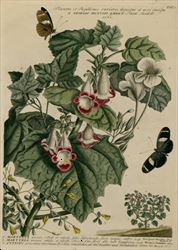Click on images to enlarge

Photo by Lalithamba - Flickr.com (CC BY 2.0)

By Marco Schmidt (Own work (own foto)) [CC-BY-SA-2.5 (http://creativecommons.org/licenses/by-sa/2.5)], via Wikimedia Commons

By Georg Ehret [Public domain], via Wikimedia Commons
Scientific Name
Martynia annua L.
Family
Martyniaceae (New South Wales, Queensland, South Australia and Western Australia)
Pedaliaceae (Northern Territory)
Common Names
devil's claw, devil's-claw, ice plant, iceplant, small fruit devil's claw, small-fruit devil's-claw, smallfruit devil's claw, small-fruited devil's claw, smallfruited devil's claw, tiger's claw, tiger's-claw
Origin
Native to Mexico, Central America (i.e. Belize, El Salvador, Guatemala, Honduras and Nicaragua) and the Caribbean.
Naturalised Distribution
Widely naturalised in northern Australia (i.e. in northern and central Queensland, in some parts of inland northern New South Wales, and in the northern parts of the Northern Territory).
Also naturalised overseas in south-eastern Asia (e.g. Indonesia and Malaysia) and on some Pacific islands (e.g. New Caledonia).
Habitat
This species is found in tropical, sub-tropical and semi-arid regions. It is a weed of disturbed sites, riparian areas, floodplains, roadsides, waste areas, pastures and crops.
Habit
An upright (i.e. erect) and short-lived (i.e. annual) herbaceous plant growing 0.25-2 m tall.
Distinguishing Features
- an upright short-lived herbaceous plant growing up to 2 m tall.
- its thick, greenish-coloured stems are covered in sticky hairs.
- its leaves (7-15 cm long and 6-15 cm wide) are also covered in sticky hairs and have five to seven shallow lobes.
- its tubular flowers (3-5 cm long) are pink to whitish with darker purplish markings and a line of yellow spots in the throat.
- its fruit (2.5-4 cm long and 1-2 cm wide) become woody as they mature and is tipped with two curved spine-tipped 'claws'.
Stems and Leaves
The greenish coloured stems are relatively thick, much-branched and covered in sticky (i.e. glandular) hairs.
The oppositely arranged leaves are covered with the same sticky (i.e. glandular) hairs and are borne on stalks (i.e. petioles) 9-14 cm long. These leaves are relatively large (7-15 cm long and 6-15 cm wide), kidney-shaped (i.e. reniform) or almost circular (i.e. orbicular), and have five to seven shallow lobes.
Flowers and Fruit
The tubular flowers (3-5 cm long) are borne in small clusters (i.e. racemes) near the tips of the branches, each cluster containing several flowers. They are pink, lavender or whitish in colour with darker purplish coloured markings on the five petal lobes and a line of yellow spots in the throat. These flowers are borne on stalks (i.e. pedicels) 10-20 mm long and have two stamens. Flowering occurs during summer and autumn.
The fruit is a relatively large fleshy capsule containing two large seeds. These fruit are initially green in colour but turn grey to black and become woody as they mature. Each fruit tapers to a short curved projection (i.e. beak or horn) that splits to form two curved 'claws' topped with short spines (body of fruit 2-3 cm long and 1-2 cm wide, with horns 5-10 mm long). The seeds are brown to black in colour, oblong in shape and somewhat flattened.
Reproduction and Dispersal
This species reproduces by seeds that are retained in the 'clawed' fruit. These fruit are easily spread when they become attached to animals, clothing, farm machinery and other vehicles.
Environmental Impact
Devil's claw (Martynia annua) is regarded as a significant environmental weed in the Northern Territory, where it is actively managed by community groups. It is also regarded as a potential environmental weed in other parts of northern Australia and was recently listed as a priority environmental weed in one Natural Resource Management region.
Legislation
This species is declared under legislation in the following states and territories:
- Northern Territory: A - to be eradicated (throughout all of the Territory), and C - not to be introduced into the Territory.
- Western Australia: P1 - trade, sale or movement into the state prevented, and P2 - to be eradicated (throughout the entire state).
Management
For information on the management of this species see the following resources:
- the Northern Territory Department of Natural Resources, Environment and The Arts Agnote on this species, which is available online at http://www.nt.gov.au/weeds.
Similar Species
Devil's claw (Martynia annua) can be confused with purple-flowered devil's claw (Proboscidea louisianica) and yellow-flowered devil's claw (Ibicella lutea). These species can be distinguished by the following differences:
- devil's claw (Martynia annua) has relatively loose clusters of pink or lavender tubular flowers with darker purplish coloured markings on the five petal lobes and a line of yellow spots in the throat. Its fruit are relatively small (3-4 cm long) with very short 'claws' that are shorter than the body of the capsule.
- purple-flowered devil's claw (Proboscidea louisianica) has relatively loose clusters of purple, mauve or creamy-white coloured tubular flowers with darker purple and orange markings in the throat. Its fruit are very large (8-30 cm long) with 'claws' longer than the body of the capsule.
- yellow-flowered devil's claw (Ibicella lutea) has relatively dense clusters of tubular yellow flowers with red or purplish coloured markings in the throat. Its fruit are very large (8-25 cm long) with 'claws' longer than the body of the capsule.

